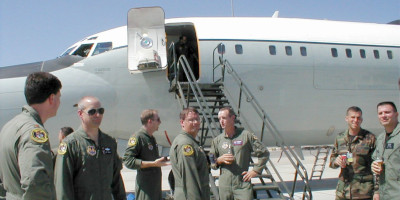
ARIA Final Touchdown
By Leigh Anne Bierstine
Public Affairs
August 24, 2001
The EC-18B Advanced Range Instrumentation Aircraft is expected to make its final touch down today at Edwards bringing to a close an historic 30-year career of recording telemetry from space vehicles such as the space shuttle and ballistic missiles.
8/24/01 – EDWARDS AIR FORCE BASE, Calif. – The drooping nose of the EC-18B ARIA hung a little lower this week as its impressive career began drawing to a close upon touch down of the first phase of its final mission here Wednesday. The last phase of its final mission, an advanced cruise missile test, is scheduled for today.
Both EC-18B Advanced Range Instrumentation Aircraft at Edwards are slated to go to the Air Force's Joint STARS program by mid-September. Joint STARS, the E-8C Joint Surveillance Target Attack Radar System, is an airborne battle management and command and control platform that provides dedicated support of ground commanders requirements.
For the past 30 years, the ARIA has been recording and relaying telemetry from space vehicles such as the space shuttle and ballistic missiles. Throughout its historic career it has operated in remote regions, gathering data that is beyond the reach of land and marine stations.
The costs associated with maintaining the aircraft and its capability became a major factor in ending the ARIA program.
"We had to make a hard decision," said Brig. Gen. Perry Lamy, former 412th Test Wing commander at Edwards, who is now director of operations at Headquarters Air Force Materiel Command. "We must continually balance accomplishing the mission with good stewardship of our resources. Continuing in the situation we faced would have made us poor stewards of taxpayer dollars."
The transfer of the last two operational aircraft to Joint Stars is a bittersweet event for the Edwards-based ARIA crew.
"In many ways, the final flight gives us closure on a mission that has been fading over the last two years," said 1st Lt. Gus Jordt of the 418th Flight Test Squadron, mission commander for the last two flights. "However, it is sad to see such a great mission, a great aircraft and great capability all go away."
Operational customers from the 49th Test and Evaluation Squadron at Barksdale Air Force Base, La., accompanied the ARIA team on several of its final missions. The Barksdale crew will soon rely on the Big Crow, an NKC-135B out of Kirtland Air Force Base, N.M., to carry on its testing of both nuclear and conventional advanced cruise missile testing.The final ARIA team is an integral part of ensuring its replacement is up to the task.
According to Capt. Aaron Almendinger, chief of ARIA technical operations, the crew has overcome numerous challenges in completing its final missions. A team of prime mission electronic equipment operators, or PMEEs as they are often called, from the 418th FLTS supports Almendinger.
"Over the past two years it has become more difficult to maintain and upgrade our aging equipment and we have continued to lose experienced people," Almendinger said. "It has been tough to keep up a good product, but the crew has done it and made it look easy."
The captain adds that without the support of the operators ARIA would not have enjoyed the success it has.
"If you take away their expert knowledge and experience, the capability is not there," he said.
Originally named Apollo Range Instrumentation Aircraft, the ARIA program was developed by NASA and the Department of Defense in the 1960s to track lunar missions, along with unmanned orbital and ballistic re-entry programs. The program came to Edwards in 1994.
Fans of the sole remaining EC-135E ARIA can find her at the Air Force Museum at Wright-Patterson Air Force Base, Ohio.
Source: Edwards Air Force Base Archives